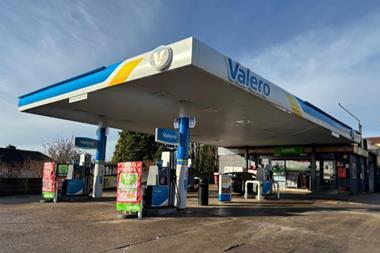Dave Kitson stands on his forecourt near Glencoe in Scotland and points down the road towards some intimidating-looking mountains: "The nearest petrol station is 16 miles in that direction," he says, raising his voice to make himself heard over the wind. Or there’s one 17 miles in the other direction. If they’re both closed, you have to carry on to Tyndrum - but that’s about 30 miles from here. And 30 miles is a long way on these roads when it’s blowing a gale and the snow’s starting to fall."
You can’t get much more remote than Dave’s Claymore Filling Station.
To get to the site on the B863 in Argyll, motorists pass through some of the most breathtaking scenery in the UK. Think of picturesque glistening lochs and roads that slice through towering mountains. And after this long drive, Claymore appears like an oasis.
Its well-stocked shop - packed with everything from tools to woolly walking socks - makes the site a lifeline for tourists, workmen, and of course the locals.
And the country roads aren’t always quiet - the forecourt can get very busy, hence the need for 17 pumps. "We once had 164 bikers all pull up at once to refuel," says Dave. "They had to take it in turns at the pumps - that was a pretty busy afternoon!"
He adds that the business hasn’t always been quite so isolated. There used to be another petrol station about three miles away.
But it’s currently closed - for refurbishment - and no-one seems to know if it will re-open anytime soon.
== helping hand ==
Dave and his dad Eric admit they wouldn’t be where they are today without a little help from the Scottish Executive. The father and son team recently took advantage of the grants scheme available north of the border, which they say is helping to save rural forecourts.
"Smaller businesses like us are disappearing fast and really need a bit of government help," says Dave. "If it wasn’t for the grant scheme there wouldn’t be any service stations up here at all."
Eric moved to the area from his native Wolverhampton to work as an engineer at the nearby ski resort.
After he and his wife Sue fell in love with Scotland their plan was to retire there. Instead they bought Claymore five years ago and recruited their son Dave and his partner, Alison Coutts, to help manage the site.
Eric first applied for money from the Rural Petrol Stations Grant Scheme (RPSGS) last year after hearing about the grants from his representative at Scottish Shell distributor Gleaner Oils.
But he hit a stumbling block when the application went to the Highlands and Islands Enterprise, which helps run the scheme for the Scottish Executive through its network of Local Enterprise Companies (LEC).
"When we first enquired about it we were turned down - because they said we weren’t a filling station," says Dave, surveying the forecourt.
"Of course we argued with them. You’ve got to chase these things and keep on their back.
"We applied again this year and this time we got the go-ahead. Then the real work started."
== subject to acceptance ==
Once retailers have been accepted on the scheme they have to get quotes for the work they want doing and send them in. It is only once the figures are accepted that the work can begin.
The Kitsons worked out the improvements would cost about £30,000, and they received the maximum grant - 50% of their estimated costs, minus the VAT.
This covered five new pumps - four quad pumps each with 50% diesel and 50% petrol, plus one high-speed diesel pump. They also got a new vapour recovery system and new pipework, with an upgrade to their POS system, pump controller and pump management system.
Work started on July 16 and was finished just one week later - and the business kept its doors open throughout.
The only downside of the scheme, according to Eric, is the fact that retailers have to pay up front for all the work and can only claim the grant money back once it’s been completed.
"We didn’t realise we wouldn’t get the grant money through until afterwards until after we’d applied for it," says Eric.
"But I was lucky to be able to get my hands on the money - I had to take it out of my pension plan. Some people wouldn’t have that sort of cash available, and they’d have to borrow it. "Can you imagine the interest on a loan for an amount like that?"
There are also a couple of other factors to be aware of. Although the application process is relatively simple, it’s essential to make sure that any estimate submitted is as accurate as possible.
The Kitsons were allowed to go 5% over budget, but any more than that and they would have been forced to pay for the extra costs themselves.
Retailers also need to budget for hidden costs. For example, Eric needed to buy a new laptop to go with the improved EPOS system, but he didn’t realise this until it was too late and he had to fund the purchase himself.
Similarly, the family ended up spending about £1,500 on overtime payments and food and drink for workers while the improvements were being made.
"If people are working a 16-hour-day out here, you have to get them a take-away," explains Eric.
But despite this, he is still full of praise for the scheme. "Without the grant we couldn’t have got the work done. We would have been forced to make do with the old petrol pumps."
Service engineer Fraser Welsh was responsible for most of the work on the site, which sells 1.3m litres of fuel per year. "The old pumps were about 15 or 20 years old," says Welsh. "We ripped out the old bases and started again from scratch. It was a big job - we ended up removing more than four tons of rubble."
Welsh has done similar work on other forecourts under the grant scheme, and says it is making a real difference to people’s lives in the area.
"It’s a great way of giving an extra bit of help to smaller businesses that need it," he adds.
Claymore is one of about 60 petrol stations which has benefited from the grants scheme, part of the Scottish Executive’s Rural Transport Fund which was set up in 1998 to improve transport in rural areas.
According to the Scottish Executive, the scheme aims to support the retention of a sustainable and accessible network of fuel supply throughout rural Scotland.
And with an alarming number of forecourts closing in the UK - at least 150 went out of business in the first six months of this year - there are calls for the scheme to be extended outside of Scotland.
Ray Holloway, director of the Petrol Retailers’ Association (PRA), believes at least 100 retailers would be eligible in England and Wales if the same criteria were used.
He is now looking at how to get MPs to introduce a similar project, with funds also extended to urban areas.
"This is still in the pipeline, it’s something we’re definitely looking into," he says. "It will be pursued, it’s something I feel very strongly about."
Other retailers who have used the Scottish scheme back up Holloway’s calls for the system to be available elsewhere.
== easy to apply ==
Fellow Gleaner Oils site Birchwood Services, in Oban on the west coast of Scotland, received a grant for £20,000 towards replacing four double pumps.
"It’s easy to apply for and we found it very useful," says manager Brian Walker, who has been at the site for five years. "And with the money we saved we were able to get the whole forecourt re-done."
The application went in at the end of 2006 and by February this year he found out they had been successful.The new pumps went in soon afterwards.
Brian’s wife and fellow manager Veronica adds: "It’s a great scheme, it’s a big outlay to replace pumps and this gave us the helping hand we really needed. I’d recommend it to anyone.
"We’re very lucky to have the grants in Scotland, I don’t know what we’d have done without it - we’d have struggled on with the old pumps I suppose. I think it would be a real boost for smaller businesses if the grants could be available nationwide."
Over in Perthshire, Blair Gurvan, manager at independent retailer Gurvan’s of Aberfeldy, is also a fan of the scheme.
He applied for financial help to replace petrol pumps and fit a new vapour recovery system at the rural site - which is 35 miles from Perth -last year. He was over the moon when the Scottish Executive agreed to help.
"We got half of the costs back on the work that needed doing, so it was a huge help," he says.
"It was reasonably quick to get the money through, too. We had to get a few quotes in, and when they agreed, we went ahead and got the work done. I think it was a matter of weeks before we got the grant through. It was very efficient.
"The pumps were 20 years old so we really needed new ones. And we were able to use the money we’d saved to do up the shop."
Blair, who preferred not to divulge how much the grant was worth, adds: "I would recommend it to anyone thinking of applying."
Meanwhile, at Claymore the Kitsons are getting ready for the onset of winter - they’re already planning a trip to Glasgow to stock up on ski poles and thermal gloves for the upcoming season. But they’re also looking forward to next spring.
The grants scheme has given Dave big ideas for the quarter-acre forecourt. "We want to get the tanks done next," he grins. "So we’re going to apply for another grant next year.
"It seems to be better to apply at the start of the financial year rather than at the end.
"Maybe there’s more money in the pot then? We’ll have to wait and see what happens."
----
=== grants: The lowdown ===
Types of work eligible for a grant
? Replacing tanks, pumps and pipework.
? Re-lining tanks, meeting groundwater protection requirements and implementing Petrol Vapour Recovery (PVR) stage 1 controls.
? The scheme also assists with the installation of tanks and dispensers for the provision of Liquefied Petroleum Gas (LPG).
What is the criteria to qualify for a grant?
? A filling station must be at least a 30-minute drive from the edge of a town with a population of more than 30,000 people.
? It must sell lead-free petrol and diesel.
? It must prove it is a viable business in the long term, with the ability to return a reasonable operating profit.
How do retailers apply?
Grants are administered on behalf of the Scottish Executive by the Highlands and Islands Enterprise and Scottish Enterprise through its network of Local Enterprise Companies (LEC). In some areas Business Gateways may also be involved. Retailers can contact their local LEC or Business Gateway or log onto [http://www.scotland.gov.uk/Topics/Transport/Road/rural-petrol-stations] for more information.



























No comments yet